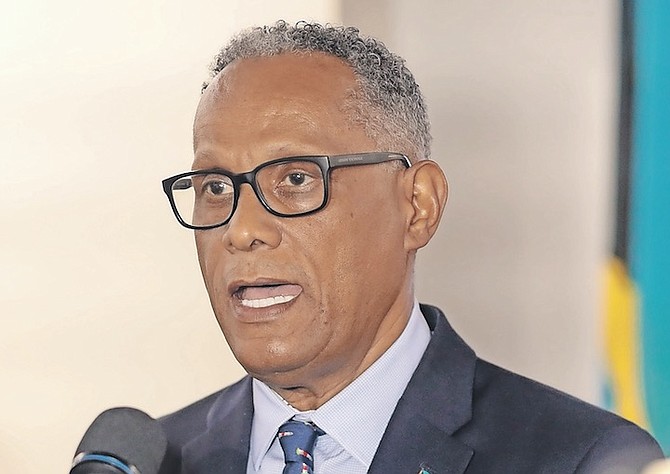By EARYEL BOWLEG
Tribune Staff Reporter
ebowleg@tribunemedia.net
HEALTH Minister Dr Michael Darville said yesterday that upon taking office he found about $50m in unbudgeted debt in his ministry.
The minister made the comments while speaking at the Inter-American Development Bank and the United Nations Economic Commission for Latin America and the Caribbean’s release of a report on the impact the pandemic had on The Bahamas.
“The national response to COVID-19 caused the Ministry of Health around $120m,” Dr Darville said.
“Our record determines or demonstrates a direct cost to the PHA of about $88.6m and the Ministry of Health just over $31.5m. The government’s 2021/2022 supplementary budget had to move very quickly - we had no resources. I don’t like to talk about what I found, but when I came into office, I found about $50m of unbudgetted debt at the Ministry of Health and Wellness. My job as minister is just trying to pay the debt. We were so challenged that we couldn’t even get resources.
“There were limited medications in our facilities - still have challenges. And so, while I’m catching up on the unbudgetted debt, I have to be able to supply what needs to be done. The government in its 2021/2022 supplementary budget reflects revised expenditure to our agencies to $271.1m of recurrent. PHA received $223.5m, NHIA received $45m, and the Ministry of Health and Wellness and the Department of Public Health had $28.6m and there was a budget of $36.6m on the capital side.
“The reason I want to speak about that is because I have been in discussion with the IDB. In our possession in the last 10 months, there has been two IDB loans and an IDB grant somewhere in the vicinity of about $65m and it is there to help our COVID response to begin to introduce new policies to improve our digital platforms and also to improve our infrastructure throughout the Family Islands.”
He added that The Bahamas spent $17.8m to execute several strategies aimed at suppressing the virus. Foremost in the strategy was that 64 percent of the total sum spent was for the protection of frontline workers, PPEs.
“I want to say, and to put on record, I want to thank all the countries around the world as well as all those agencies that came to our needs, still coming to our needs, to provide essential PPEs. The frontline workers was a cost of $11.4m. This was supported by the timely donations through PAHO and other philanthropic groups and private citizens in our country that came to our aid,” the minister explained.
The remainder of the $17.8m was spent on three main purposes - one of them being timely testing, according to the minister.
“You see we talk about evidence-based testing medicine and if we were looking at what was going on around the world free testing was paramount and it was demonstrated that where we are to where we are today is directly related to having access to testing free of charge so that they can get a better understanding of their status and can execute the responsibility of self-quarantine and isolation,” Dr Darville said.
The minister highlighted the country’s free testing programme as “value for money”.
“It was important for us to implement this tool along with a vaccination programme to ensure that any Bahamian throughout the Commonwealth of The Bahamas if exposed or if concerned with symptoms can have access to free testing which was on a digital platform and red flagged.”
“So, we were able to look into the country, through rapid antigen test through our digital platform to red flag and those individuals went to our contact tracing and we had to improve the contact tracing capability. These effects resulted in 32,000 RT-PCR cases being advised to isolate. The Ministry of Health tracked 50,000 contacts, investigated 2,000 clusters of infections throughout our Family Islands.
He stated that for The Bahamas the third wave was of the longest duration, goes on record as having up to about 42 percent of patient caseload in the hospital, with the highest human cost.





Comments
Use the comment form below to begin a discussion about this content.
Sign in to comment
Or login with:
OpenID